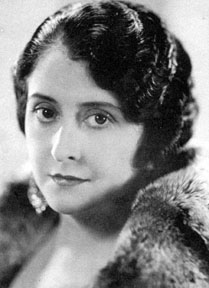Clara Kimball Young (Clara Kimball Young)

Actress. Known today only to silent film enthusiasts, she was a hugely popular star of the World War I era. Born in Chicago into a show business family, she made her vaudeville debut at age three and entered films with the Vitagraph studio in 1909. She was initially cast in one-reel comedies, but under the guidance of her first husband, actor-director James Young, found her forte playing worldly, sophisticated ladies in films like “Delayed Proposals” (1913), “Without a Soul” (1914), and “My Official Wife” (1914). Raven-haired, with a broad oval face and saucer eyes, Young was considered a great beauty in her time. She was voted the screen’s most popular actress in a 1914 poll and received over 7000 fan letters a week. To prevent her from decamping to another studio Vitagraph sent Young on an extended tour of Japan, but she left Vitagraph in 1915. She divorced James Young the same year. After signing an exclusive contract with producer Lewis J. Selznick (and becoming his mistress to clinch the deal), Young’s fame peaked with her performances in the title roles of “Camille” (1915) and “Trilby” (1915). She had an eye for promising leading men and was credited with giving future stars Edmund Lowe and Milton Sills their start in films. Her last big hit, “Eyes of Youth” (1919), featured a sexy newcomer named Rudolph Valentino. Young was one of Hollywood’s first real divas, a temperamental, high-maintenance woman accustomed to getting her way onscreen and off. By her own admission she spent more money than she cared to count and was embroiled in a dozen lawsuits with producers, business partners, even fans. (An autograph seeker once sued Young for “emotional injury”, claiming the actress had kicked her in the behind). Her appetite for men took an unfortunate turn when she became enamoured with her new agent, Harry Garson, in 1919. The distinguished-looking but shady Garson dreamed of becoming a major player in Hollywood. He took charge of Young’s career and finances and proceeded to manage both into the ground. After alienating the star from all the big studios with his outrageous demands, Garson formed his own company (with Young’s money) and personally directed her in eight pictures, all of them flops. When Young finally gave Garson the boot in 1927, her wealth and fame were history. Talkies saw her doing extra work for $20 a day, a far cry from the $200,000 a year she had once commanded. In 1932 most of Young’s belongings were sold at public auction to pay her creditors. She was too proud to seek bankruptcy protection. Young made no films after 1941, but late in life she gained some local notoriety as a sort of woman-about-town, sought after at Old Hollywood parties for her eccentric manners and salty conversation. She handled her fall from grace with surprising aplomb, or at least she pretended to. When a reporter found Young living in a tiny apartment without a single memento of her career, she explained, “Oh, I threw away all my old scrapbooks and things. I live today, in the rocket-ship age. To hell with the past!” She died at the Motion Picture Country Home. (bio by: Bobb Edwards) Family links: Spouse: James Young (1872 – 1948)* *Calculated relationshipCause of death: Stroke
Born
- September, 06, 1890
- USA
Died
- October, 10, 1960
- USA
Cause of Death
- Stroke
Cemetery
- Grand View Memorial Park
- California
- USA

